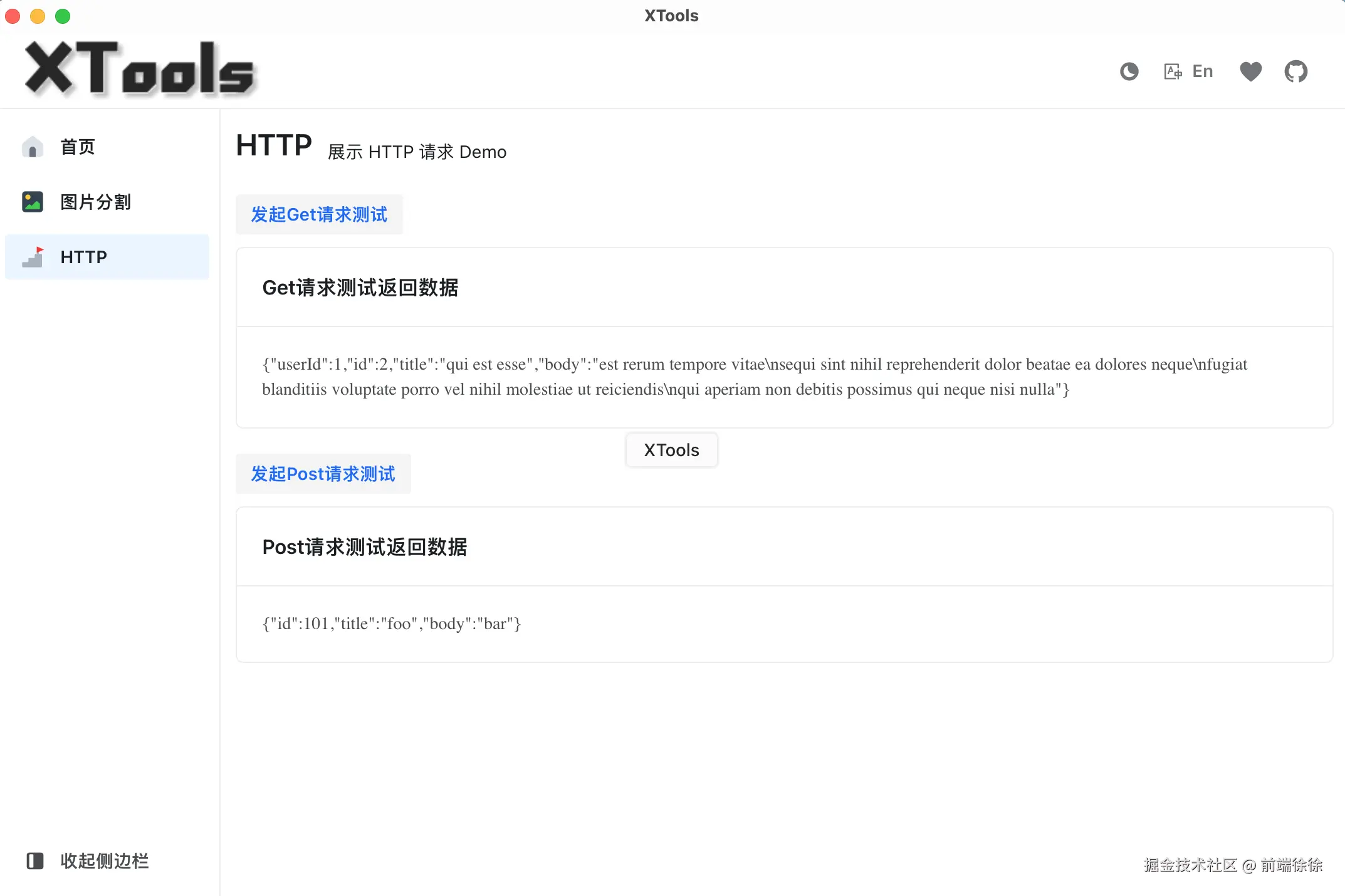Tauri HTTP 请求开发
大家好,我是徐徐。今天的主题是如何在 Tauri 中发起 HTTP 请求。
前言
前面铺垫了很多,但是我们一直都是在整个应用的架构层面做一些设计和开发,我们现在更近一步,集成 HTTP 支持,这意味着你的桌面应用现在可以与远程服务器通信了!
安装依赖
其实要集成 HTTP 是非常简单的,Tauri 生态里面有现成工具包,当然你可以 axios 这类请求包都行,但是需要注意适配器的问题,打包后有可能会有无法使用的问题。
我这里推荐使用 Tauri 生态里面有现成工具包,但是这个包也有个缺点,就是在浏览器控制台中是无法看到请求的,因为他是 Tauri 里面的 rust 去帮我们调用请求从而绕过了 webview2 前端框架,不过这个是官网推荐的包,在解决方案这块是有保障的,不会出现一些奇奇怪怪的问题。
npm install -D @tauri-apps/api修改配置
依赖安装完了,其实还不能完全随心所欲的发起请求,我们需要修改一些配置。本质上,你是在告诉 Tauri允许向特定域名发起 HTTP 和 HTTPS 请求。这对于让你的桌面应用访问指定的API至关重要,你可以从允许向localhost 发起 HTTP 请求开始测试,下面是一个简单的配置例子。
- src-tauri/tauri.conf.json
{
//..
"tauri": {
"allowlist": {
"http": {
"all": true,
"request": true,
"scope": [
"http://localhost/*",
"http://jsonplaceholder.typicode.com/*"
]
}
},
}
// ...
}请求类编码实现
这里的编码就是封装一个简单的 httpClient,然后在各个地方引用,跟常规的前端请求封装没有特别大的差别。 下面是简单的封装。
- src/http/client.ts
import { fetch, FetchOptions, Response } from "@tauri-apps/api/http";
interface RequestInterceptor {
onRequest(config: FetchOptions): FetchOptions | Promise<FetchOptions>;
}
interface ResponseInterceptor {
onResponse<T>(response: Response<T>): Response<T> | Promise<Response<T>>;
onError(error: Error): void | Promise<void>;
}
class HttpClient {
private baseURL: string = '';
private requestInterceptors: RequestInterceptor[] = [];
private responseInterceptors: ResponseInterceptor[] = [];
private constructor() {}
private static instance: HttpClient;
static getInstance(): HttpClient {
if (!HttpClient.instance) {
HttpClient.instance = new HttpClient();
}
return HttpClient.instance;
}
setBaseURL(baseURL: string): void {
this.baseURL = baseURL;
}
addRequestInterceptor(interceptor: RequestInterceptor): void {
this.requestInterceptors.push(interceptor);
}
addResponseInterceptor(interceptor: ResponseInterceptor): void {
this.responseInterceptors.push(interceptor);
}
private async executeRequestInterceptors(config: FetchOptions): Promise<FetchOptions> {
for (const interceptor of this.requestInterceptors) {
config = await interceptor.onRequest(config);
}
return config;
}
private async executeResponseInterceptors<T>(response: Response<T>): Promise<Response<T>> {
for (const interceptor of this.responseInterceptors) {
response = await interceptor.onResponse(response);
}
return response;
}
private async executeErrorInterceptors(error: Error): Promise<void> {
for (const interceptor of this.responseInterceptors) {
await interceptor.onError(error);
}
}
async request<T>(url: string, options: FetchOptions): Promise<T> {
const config = await this.executeRequestInterceptors(options);
try {
const response = await fetch<T>(this.baseURL + url, config);
const processedResponse = await this.executeResponseInterceptors(response);
return processedResponse.data;
} catch (error) {
await this.executeErrorInterceptors(error as Error);
throw error;
}
}
}
const httpClient = HttpClient.getInstance();
export default httpClient;封装一个 HTTP 请求类,添加常规的配置,拦截器,响应器这些,然后再抽离一层出来,供外部使用。
- src/http/index.ts
import httpClient from './client';
import { FetchOptions, Response, ResponseType,Body } from "@tauri-apps/api/http";
httpClient.setBaseURL('http://jsonplaceholder.typicode.com');
httpClient.addRequestInterceptor({
onRequest(config: FetchOptions): FetchOptions {
config.headers = {
...config.headers,
};
return config;
}
});
httpClient.addResponseInterceptor({
onResponse<T>(response: Response<T>): Response<T> {
if (!response.ok) {
throw new Error(`HTTP error! status: ${response.status}`);
}
return response;
},
onError(error: Error): void {
console.error('HTTP request error:', error);
throw error;
}
});
const get = async <T>(url: string) => {
return httpClient.request<T>(url, { method: 'GET', responseType: ResponseType.JSON })
}
const post = async <T>(url: string,data:Record<string, unknown>) => {
return httpClient.request<T>(url, { method: 'POST', body:Body.json(data), responseType: ResponseType.JSON })
}
export default {
get,
post
}上面的代码主要是设置请求和相应拦截,然后封装了简单的 get 和 post 请求。
在页面中使用
import { useState } from "react"
import { Button, Card } from "@douyinfe/semi-ui"
import http from "@/http"
const Http = () => {
const [getResponse, setGetResponse] = useState<string>('')
const [postResponse,setPostResponse] = useState<string>('')
const getFetchTest = () => {
http.get("/posts/2").then(res => {
setGetResponse(JSON.stringify(res))
})
}
const postFetchTest = () => {
http.post("/posts",{
"id":1,
"title":"foo",
"body":"bar",
}).then(res => {
setPostResponse(JSON.stringify(res))
})
}
return (
<div>
<Button onClick={getFetchTest}>发起Get请求测试</Button>
<Card title="Get请求测试返回数据" style={{marginTop:10}}>
{getResponse}
</Card>
<div style={{marginTop:20}}>
<Button onClick={postFetchTest}>发起Post请求测试</Button>
<Card title="Post请求测试返回数据" style={{marginTop:10}}>
{postResponse}
</Card>
</div>
</div>
)
}
export default Http非常简单的页面,到这里,在 Tauri 中进行 HTTP 请求的功能就实现了。 
源码地址
https://github.com/Xutaotaotao/XTools/tree/feature-http
结语
这篇教程只是简单地在实现了 Tauri 中进行 HTTP 请求的功能,但是有了这个功能之后就可以做很多事情了,桌面端应用也充满了生机。如果大家有任何 Tauri 相关的问题,欢迎和我讨论。
